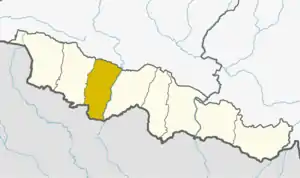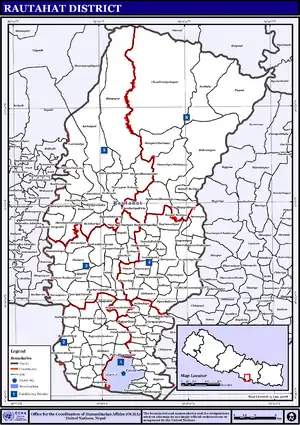Rautahat District
Rautahat District (Nepali: रौतहट जिल्लाⓘ), a part of Madhesh Province, is one of the seventy-seven districts of Nepal. The district headquarter is Gaur, including municipalities like Garuda, Chandrapur, Paroha, covers an area of 1,126 km2 and had a population of 545,132 in 2001 and 686,722 in 2011. This district has a total of 2 VDCs and 16 municipalities. Among other districts, Rautahat has the largest percent of Muslims in Nepal, about 19.7% (135,283 persons in 2011).[1] The most Muslim densely Village Bairiya بيريا (in Rautahat district) is an example for secularism in Nepal. Sri Ram Sugar Mill is the only sugar mill located in Garuda municipality. The well known shiva temple located in Shivnagar, which is looked after by Sah and Jha family. The historical temple of Goddess Durga is in Matsari.Every year, the temple welcomes millions of devotees from different parts of Nepal and India as well on the occasion of Navaratri. Late Shri Gulab Narayan Jha, the first person to represent madhesis in politics, was permanent resident of this village. There is a place called Najarpur in Chandrapur, Rautahat where whole village is vegetarian. They are not even allowed to buy or sell any alcoholic beverages and buying and selling of tobacco products is also prohibited.
Rautahat District
रौतहट जिल्ला | |
|---|---|
 Fields near Matsari | |
 Rautahat District (dark yellow) in Madhesh Province | |
| Country | Nepal |
| Region | Mithila |
| Province | Madhesh Province |
| Established | During Rana regime |
| Headquarter | Gaur |
| Local bodies | List
|
| Government | |
| • Type | District Coordination |
| • Body | Rautahat DCC |
| • Chief | Ramayodhya Ray Yadav |
| • Deputy Chief | Mahesh Baitha |
| Area | |
| • Total | 1,126 km2 (435 sq mi) |
| Population (2011) | |
| • Total | 686,723 |
| • Density | 610/km2 (1,600/sq mi) |
| Time zone | |
| Kathmandu | UTC+05:45 (NPT) |
| Website | dccrautahat |
There is a place called Katahariya which lies in Katahariya Municipality itself. It is famous for katiya meat.Katiya is an earthen pot in which mainly goat meat is cooked with the help of charcoal.It is very delicious dish among non-veg people.
Nunthar is a famous place for picnic and there is a temple of lord shiva which is located in Paurai Bagmati, Rautahat.
Rautahat district of Nepal is rich in natural resources. There are varieties of trees and varieties of medicinal herbs in the forest of Rautahat. There are dense forest with varieties of Wild Animals in the forest of Rautahat. The Animals include Cheetah, Tiger, Elephant, varieties of Snakes, etc. There are also varieties of birds in the forest of Rautahat. The bird includes Dove, hornbill, parrots, pigeons, cuckoo,sparrow,crow and many more.
Geography and Climate
| Climate Zone[2] | Elevation Range | % of Area |
|---|---|---|
| Lower Tropical | below 300 meters (1,000 ft) | 94.4% |
| Upper Tropical | 300 to 1,000 meters 1,000 to 3,300 ft. |
5.6% |
The Manusmara River flows through the district, and feeds a canal for irrigating 3200 hectares of land.[3]
Demographics
| Census year | Pop. | ±% p.a. |
|---|---|---|
| 1981 | 332,526 | — |
| 1991 | 414,005 | +2.22% |
| 2001 | 545,132 | +2.79% |
| 2011 | 686,722 | +2.34% |
| 2021 | 825,623 | +1.86% |
| Source: Citypopulation[4] | ||
At the time of the 2011 Nepal census, Rautahat District had a population of 686,722.
As their first language, 60.3% spoke Bajjika, 19.3% Urdu, 6.1% Nepali, 4.3% Bhojpuri, 3.3% Tharu, 3.0% Maithili, 1.7% Tamang, 0.4% Magar, 0.2% Majhi, 0.2% Newar, 0.2% Rai, 0.1% Bengali, 0.1% Danuwar, 0.1% Doteli, 0.1% Hindi, 0.1% Yakkha and 0.1% other languages.[5]
Ethnicity/caste: 19.7% were Musalman, 12.2% Yadav, 5.7% Kurmi, 5.6% Teli, 4.5% Kanu, 4.5% Tharu, 3.8% Chamar/Harijan/Ram, 3.3% Kalwar, 2.9% Dusadh/Paswan/Pasi, 2.9% Mallaha, 2.6% Hill Brahmin, 2.4% Koiri/Kushwaha, 2.4% Tatma/Tatwa, 2.0% Dhobi, 2.0% Kathabaniyan, 2.0% Lohar, 1.8% Kumhar, 1.8% Tamang, 1.6% Nuniya, 1.5% Bin, 1.4% Terai Brahmin, 1.4% Hajam/Thakur, 1.3% Chhetri, 1.1% Musahar, 1.1% Sonar, 0.7% Magar, 0.6% Rajput, 0.5% Baraee, 0.5% Sanyasi/Dasnami, 0.4% Danuwar, 0.4% Kahar, 0.4% Kayastha, 0.4% Majhi, 0.4% Newar, 0.4% Sudhi, 0.3% Dhanuk, 0.3% Kami, 0.3% Mali, 0.3% Rai, 0.3% other Terai, 0.2% Damai/Dholi, 0.2% Dhunia, 0.2% Gaderi/Bhedihar, 0.1% Badhaee, 0.1% Bengali, 0.1% other Dalit, 0.1% Dom, 0.1% foreigners, 0.1% Gharti/Bhujel, 0.1% Gurung, 0.1% Halkhor, 0.1% Kumal, 0.1% Marwadi, 0.1% Pahari, 0.1% Sunuwar, 0.1% Thakuri, 0.1% Yakkha and 0.1% others.[6]
Religion: 77.8% were Hindu, 19.7% Muslim, 1.8% Buddhist, 0.2% Christian, 0.2% Prakriti, 0.1% Kirati and 0.3% others.[7]
Literacy: 41.6% could read and write, 3.7% could only read and 54.4% could neither read nor write.[8]
Administration
The district consists of twenty municipalities, out of which eighteen are urban municipalities and two are rural municipalities. These are as follows:
- Baudhimai Municipality
- Brindaban Municipality
- Chandrapur Municipality
- Dewahi Gonahi Municipality
- Gadhimai Municipality, Nepal
- Garuda Municipality
- Gaur Municipality
- Gujara Municipality
- Ishanath Municipality
- Katahariya Municipality
- Madhav Narayan Municipality
- Maulapur Municipality
- Paroha Municipality
- Phatuwa Bijayapur Municipality
- Rajdevi Municipality
- Rajpur Municipality
- Durga Bhagwati Rural Municipality
- Yamunamai Rural Municipality
Former Village Development Committees (VDCs) and Municipalities

- Ajagaibi
- Akolawa
- Auraiya
- Badaharwa
- Bagahi
- Bahuwa Madanpur
- Bairiya
- Banjaraha
- Bariyarpur
- Basantapatti
- Basatpur
- Basbiti Jingadiya
- Baudhimai
- Bhalohiya
- Bhediyahi
- Birtiprastoka
- Bishrampur
- Bisunpurwa Manpur
- Brahmapuri
- Chandrapur Municipality
- Chandhiya
- Debahi
- Dharampur
- Dharhari
- Dipahi
- Dumariya Bazar,Matiaon
- Gadhi
- Gamhariya Birta
- Gamhariya Parsa
- Gangapipra
- Garuda Municipality
- Gaur Municipality
- Gedahiguthi
- Gunahi
- Hajminiya
- Hardiya Paltuwa
- Harsaha
- Hathiyahi
- Inarbari Jyutahi
- Inaruwa
- Jatahare
- Jayanagar
- Jethrahiya
- Jhunkhunwa
- Jingadawa Belbichhwa
- Jingadiya
- Jowaha
- Judibela
- Kanakpur
- Karkach Karmaiya
- Karuniya
- Katahariya
- Khesarhiya
- Laksminiya
- Laksmipur
- Laksmipur Belbichhawa
- Lokaha
- Madanpur
- Malahi
- Maryadpur
- Bhasedhawa
- Mathiya
- Matsari
- Mithuawa
- Mudwalawa
- Narkatiya Guthi
- Pacharukhi
- Patahi
- Pataura
- Pathara Budharampur
- Paurai
- Phatuha Maheshpur
- Phatuha Harsaha
- Pipariya
- Pipra Bhagwanpur
- Pipra Pokhariya
- Pipra Rajbara
- Pothiyahi
- Pratappur Paltuwa
- Prempur Gunahi
- Purainawma
- Raghunathpur
- Rajdevi
- Rajpur Pharhadawa
- Rajpur Tulsi
- Ramauli Bairiya
- Rampur Khap
- Rangapur
- Sakhuwa
- Sakhuwa Dhamaura
- Samanpur
- Sangrampur
- Santapur
- Santpur
- Sarmujawa
- Saruatha
- Saunaraniya
- Sawagada
- Shitalpur Bairgania
- Simara Bhawanipur
- Sirsiya
- Tejapakar
- Tengraha
- Tikuliya
Education
Private Schools: Bal Niketan Higher Secondary School, Chandrapur, Rautahat Moonlight Academy, Chandranigahpur, Rautahat Pathibhara Secondary School, Chandranigahpur, Rautahat Mount Everest English School, Chandrapur, Rautahat Namuna English Boarding School, Cha.pur Bazaar, Nepal police school, basbiti jigadiya rautahat,Himalayan Public School Sukdev Chowk
Shree Juddha Campus
The origin of this campus goes back to its former "Shree Juddha Higher Secondary School" and further "Shree Juddha Secondary School", the third-oldest school in Nepal inaugurated by Juddha Shamsher Jang Bahadur Rana during Rana dynasty. The school got its name from his name. The institution has about 1500 students.

Shree Juddha Campus offers bachelor courses like Bachelor of Education, Bachelor of Arts, Bachelor of Commerce, etc. while its former entities "Shree Juddha Higher Secondary School" offers 10+2 courses of National Examinations Board and "Shree Juddha Secondary School" offers up to 10th class of School Leaving Certificate (Nepal).
It runs a separate school for blind students.
Gauri Shankar Yadav Campus
It offers bachelor courses like B.Ed. and 10+2 courses of National Examinations Board.
Notable people
- Madhav Kumar Nepal, chairman of CPN (Unified Socialist) and former Prime Minister of Nepal
- Sunil Kumar Yadav, Nepali Congress leader and former member of Constituent Assembly
- Anil Kumar Jha, senior leader of DSP, N, former Minister of Industry and Member of House of Representatives
- Bansidhar Mishra, leader of CPN (Unified Socialist), former parliantrian and former Ambassador of Nepal to Bangladesh
- Mohammad Aftab Alam, Nepali Congress leader and Member of House of Representatives
References
- NepalMap Religion
- The Map of Potential Vegetation of Nepal - a forestry/agroecological/biodiversity classification system (PDF), Forest & Landscape Development and Environment Series 2-2005 and CFC-TIS Document Series No.110, 2005, ISBN 978-87-7903-210-1, retrieved Nov 22, 2013
- Acharya, Madhu Raman (1986). Nepal concise encyclopedia: a comprehensive dictionary of facts and knowledge about the kingdom of Nepal ... Geeta Sharma. p. 103.
- "NEPAL: Administrative Division". www.citypopulation.de.
- NepalMap language
- NepalMap Caste
- NepalMap Religion
- NepalMap Literacy